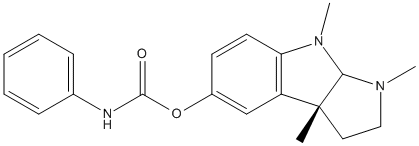Posiphen
Phenyl carbamoyl analogues of physostigmine-esrine were developed to provide longer acting and better tolerated Alzheimer's disease treatment. Posiphen (enantiomer of phenserine: ANVS401 (+)-phenserine) is under investigation in clinical trial NCT02925650 (Early Alzheimer's Disease) Posiphen does not inhibit AChE or BChE, but its major and minor metabolites (+)-N1-norPosiphen and (+)-N1,N8-bisnorPosiphen, respectively, possessed modest AChE inhibitory activity.
General
Type : Derivative of physostigmine-eserine,Carbamate,Drug,Indole
Chemical_Nomenclature : [(3aS,8bR)-3,4,8b-trimethyl-2,3a-dihydro-1H-pyrrolo[2,3-b]indol-7-yl] N-phenylcarbamate
Canonical SMILES : CC12CCN(C1N(C3=C2C=C(C=C3)OC(=O)NC4=CC=CC=C4)C)C
InChI : InChI=1S\/C20H23N3O2\/c1-20-11-12-22(2)18(20)23(3)17-10-9-15(13-16(17)20)25-19(24)21-14-7-5-4-6-8-14\/h4-10,13,18H,11-12H2,1-3H3,(H,21,24)\/t18-,20+\/m0\/s1
InChIKey : PBHFNBQPZCRWQP-AZUAARDMSA-N
Other name(s) : posiphen,(+)-phenserine,(+)-Posiphen,Phenserine, (+)-
MW : 337.4
Formula : C20H23N3O2
CAS_number : 116839-68-0
PubChem : 11249342
UniChem : PBHFNBQPZCRWQP-AZUAARDMSA-N
IUPHAR :
Wikipedia :

Target
References (4)
| Title : Post-treatment with Posiphen Reduces Endoplasmic Reticulum Stress and Neurodegeneration in Stroke Brain - Yu_2020_iScience_23_100866 |
| Author(s) : Yu SJ , Wu KJ , Bae E , Wang YS , Chiang CW , Kuo LW , Harvey BK , Greig NH , Wang Y |
| Ref : iScience , 23 :100866 , 2020 |
| Abstract : Yu_2020_iScience_23_100866 |
| ESTHER : Yu_2020_iScience_23_100866 |
| PubMedSearch : Yu_2020_iScience_23_100866 |
| PubMedID: 32058974 |
| Title : Synthesis of the Alzheimer Drug Posiphen into its Primary Metabolic Products (+)-N1-norPosiphen, (+)-N8-norPosiphen and (+)-N1, N8-bisnorPosiphen, their Inhibition of Amyloid Precursor Protein, alpha -Synuclein Synthesis, Interleukin-1beta Release, and Cholinergic Action - Yu_2013_Antiinflamm.Antiallergy.Agents.Med.Chem_12_117 |
| Author(s) : Yu QS , Reale M , Kamal MA , Holloway HW , Luo W , Sambamurti K , Ray B , Lahiri DK , Rogers JT , Greig NH |
| Ref : Antiinflamm Antiallergy Agents Med Chem , 12 :117 , 2013 |
| Abstract : Yu_2013_Antiinflamm.Antiallergy.Agents.Med.Chem_12_117 |
| ESTHER : Yu_2013_Antiinflamm.Antiallergy.Agents.Med.Chem_12_117 |
| PubMedSearch : Yu_2013_Antiinflamm.Antiallergy.Agents.Med.Chem_12_117 |
| PubMedID: 23360256 |
| Title : The anticholinesterase phenserine and its enantiomer posiphen as 5'untranslated-region-directed translation blockers of the Parkinson's alpha synuclein expression - Mikkilineni_2012_Parkinsons.Dis_2012_142372 |
| Author(s) : Mikkilineni S , Cantuti-Castelvetri I , Cahill CM , Balliedier A , Greig NH , Rogers JT |
| Ref : Parkinsons Dis , 2012 :142372 , 2012 |
| Abstract : Mikkilineni_2012_Parkinsons.Dis_2012_142372 |
| ESTHER : Mikkilineni_2012_Parkinsons.Dis_2012_142372 |
| PubMedSearch : Mikkilineni_2012_Parkinsons.Dis_2012_142372 |
| PubMedID: 22693681 |
| Title : The experimental Alzheimer's disease drug posiphen [(+)-phenserine] lowers amyloid-beta peptide levels in cell culture and mice - Lahiri_2007_J.Pharmacol.Exp.Ther_320_386 |
| Author(s) : Lahiri DK , Chen D , Maloney B , Holloway HW , Yu QS , Utsuki T , Giordano T , Sambamurti K , Greig NH |
| Ref : Journal of Pharmacology & Experimental Therapeutics , 320 :386 , 2007 |
| Abstract : Lahiri_2007_J.Pharmacol.Exp.Ther_320_386 |
| ESTHER : Lahiri_2007_J.Pharmacol.Exp.Ther_320_386 |
| PubMedSearch : Lahiri_2007_J.Pharmacol.Exp.Ther_320_386 |
| PubMedID: 17003227 |